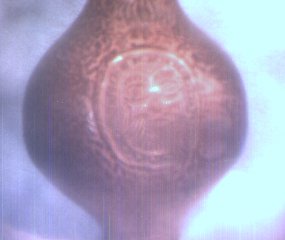
Excavated - London in 1890
Trinidad, TT, WI
| :-) |  |
The Urn in Trinidad Excavated - London in 1890 Trinidad, TT, WI |
|
Tracing an Urn's European origins. |
|
| THE URN Presently in Trinidad, West Indies - Excavated in London, England, in 1890; pictures here are for examination by staff of the Marine Archaeology Department at the Kalmar Läns Museum, Kalmar, Sweden. A similar urn is believed to have been found from the wreck of the Royal Ship Kronan - 1676 |
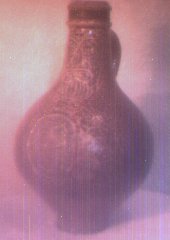 |
| This urn is of heavy-earthenware and bulges in the middle to stand on a narrow round base. It carries a mottled brown glaze. Girth = 13 cm A sturdy handle at the back is attached to the top of the urn. |
|
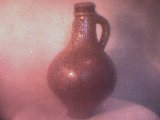 |
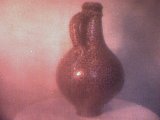 |
| THE MESSAGE Engraved on a silver band soldered around the throat-lip of this urn, is the inscription: The inscription relates to London, England. CITY = The city of London. MITRE ST = Mitre Street; which is about ½ mile north from the River Thames, virtually in the middle between London Bridge and Tower Bridge; just North of the Tower of London and the Smithfield docks. An area dense in maritime history with links to shipping and trade that spans continents and time. Nothing is known about whom may have fitted this useful snippet of history to the urn. A fortuitous message from the past attesting to the assiduousness of Victorian England. THE HANDLE |
|
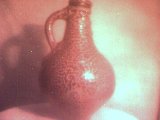 |
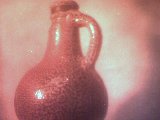 |
 Just about discernible in this preliminary image; is a circular dimple in the centre of the pointed decoration that de-marks the join of the lower handle. Just about discernible in this preliminary image; is a circular dimple in the centre of the pointed decoration that de-marks the join of the lower handle.The potter used a circular object to depress the soft unfired-clay of the handle into the material of the main body of the urn; possibly to insure a good bond. |
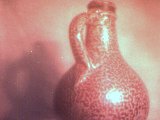 |
| FACES OF MARK |
|
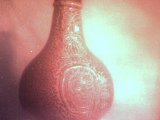 |
The front of the urn bears two faces in relief, one below the other. |
| A scowling bearded man at the top of the urn-neck. | 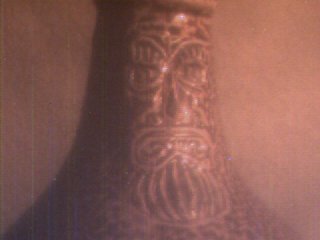 |
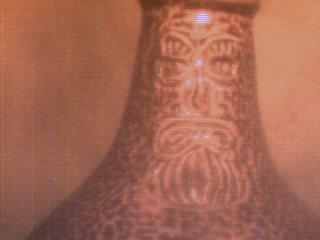 |
| A softer (apparantly more feminine ?) yet still fierce, toothy and bearded face, completely surrounded by decoration, lies in the centre of the bulge. This middle image of the urn shows some signs of damage. |
|
A depression on the lower right cheek, that has broken the continuity of the surround, was possibly made by accident before firing; as the glaze is intact over it.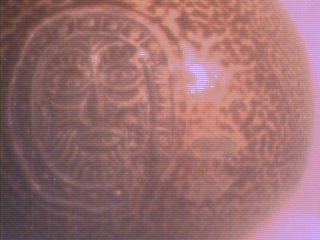 |
DAMAGE Three other marks are more curious. One is outlined by the overexposure due to the reflected light in the upper image, to the right and just under centre of the eye level. It appears a contemporary small dirty dry-patch; made just before firing, where the glaze appears mixed and fired with the clay; rather than being fused over it. At first thought to be chips or wear marks; roundness at the edge of the glaze before showing the fired clay beneath and concentrations of brown colouring along the glaze edge; indicates that the urn may have been in contact with some other object whilst firing was in progress. |
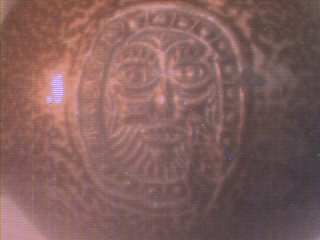 |
|
| SUMMARY Carrying either an owners mark or an early version of a product mark; the age and use of this urn remains speculative until some light is shed on its origins by the experts in Sweden or elsewhere. Standing in the background as a curious object d'art, long awaiting put-off attentions, the Trinidad Urn was remembered following a TV broadcast on the National Geographic channel. On the evening of the 15th May 2001, the National Geographic were airing the finds of a marine archaeology team working on the 1676 wreck of the Swedish man-o-war - The Royal Sail Ship Kronan. A brief glimpse of a similar urn appeared on this programme. With three decks of brass cannon, the ship floundered in the fright of battle. Being somewhat unstable, and the lower cannon deck a few feet above the waterline; under heavy sail when caused to turn quickly by those at the helm, she began to take in water, started to capsize; caught fire amid-ship and suffered an explosion and then sank. The battle is supposed to have involved about 100 ships, 2 being lost, and included the navies of the Danes and Dutch in opposition to the Swedes. The relics to the saga of the Royal Sail Ship Kronan that sank some 3 km off the south-east coast of the Swedish isle of Öland in the Baltic Sea, can be found on a website run by the Kalmar Lãns Museum, Kalmar, Sweden, where the ships history and a glimpse of some of the more pertinent objects recovered are displayed. Kronan Projektet - Regalskeppet Kronan (English Version) http://www.kalmarlansmuseum.se/kronan/english/ Out of a stable of some 22,000 objects recovered; it is hoped that the cousin to the Trinidad Urn shown on this page may exist; and hence its history, age and use brought to light. The authors guess is that the urn represents a contemporary container for as high octane an alcoholic beverage, and of good quality, that could be managed by brewers of that time. Schnapps, Vodka, Brandy, Whiskey or whatever; perhaps but lastly, wine; a spirit of the wealthy nevertheless. The comments of the experts will be presented on this page, should a reply be received. tobagojo in Trinidad - 20th May 2001 |
|
[The footnote below, a 'legasy' comment, is an amusing reminder as to how much internet attitudes and computer technology have advanced over the past decade+ :: tobagojo 2014] The images on this page were recorded using an old QUICKCAM digital video camera. Not of the best image quality; nevertheless it is hoped of sufficient definition to convey the information required by this enquiry.To be able to view these images at their highest definition offered on this page; Set your screen resolution to: 640 x 480 pixels - High (16 bit) or True Colour (32 bit). |
|
| :-) |
|
© 2001: tobagojo@gmail.com - 20010519 - 2m20140615
Historic Update: 21 May 2001; Last Update: 20 June 2014 22:24:00 TT Processed by: Jeremy G de Barry |
|